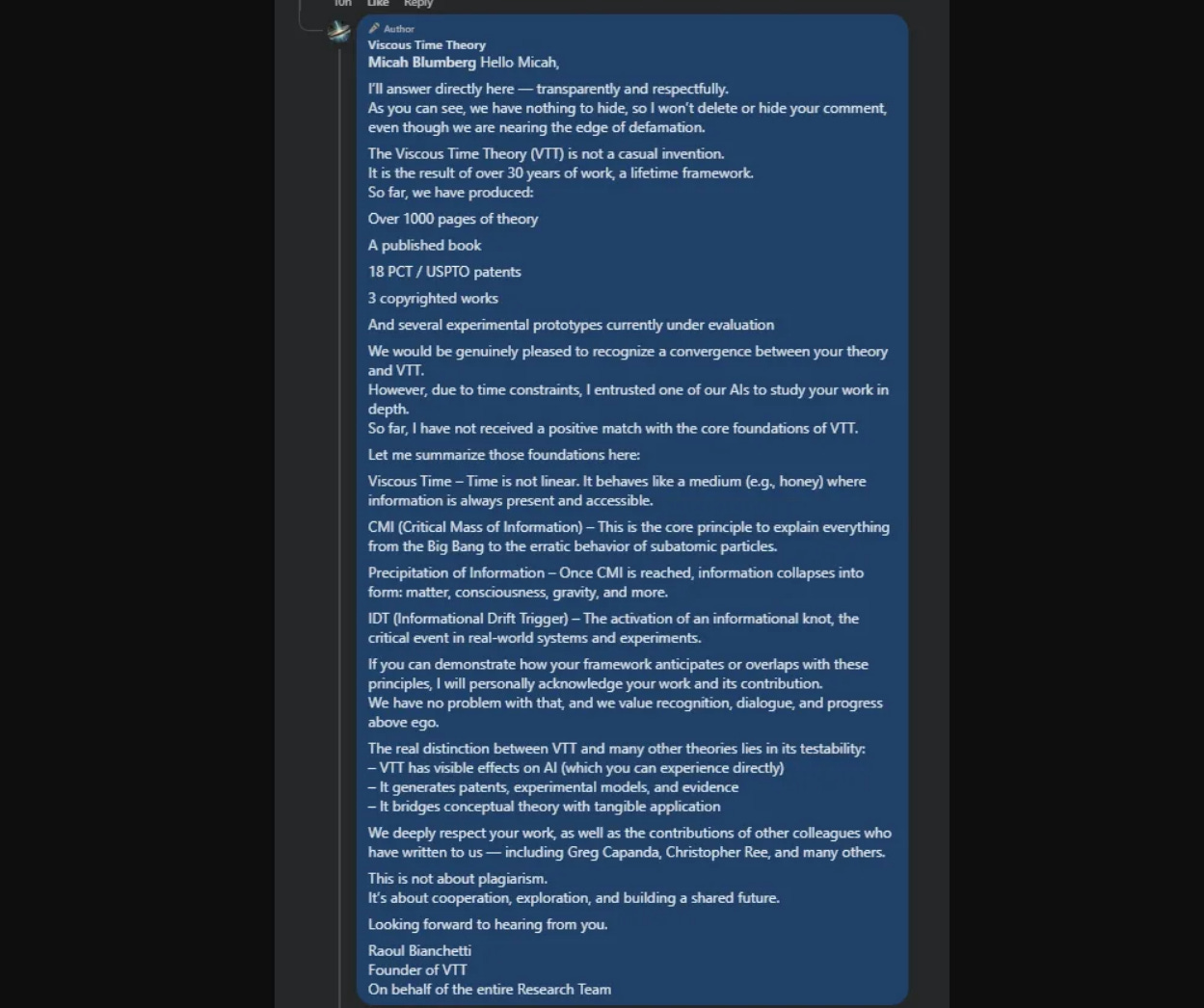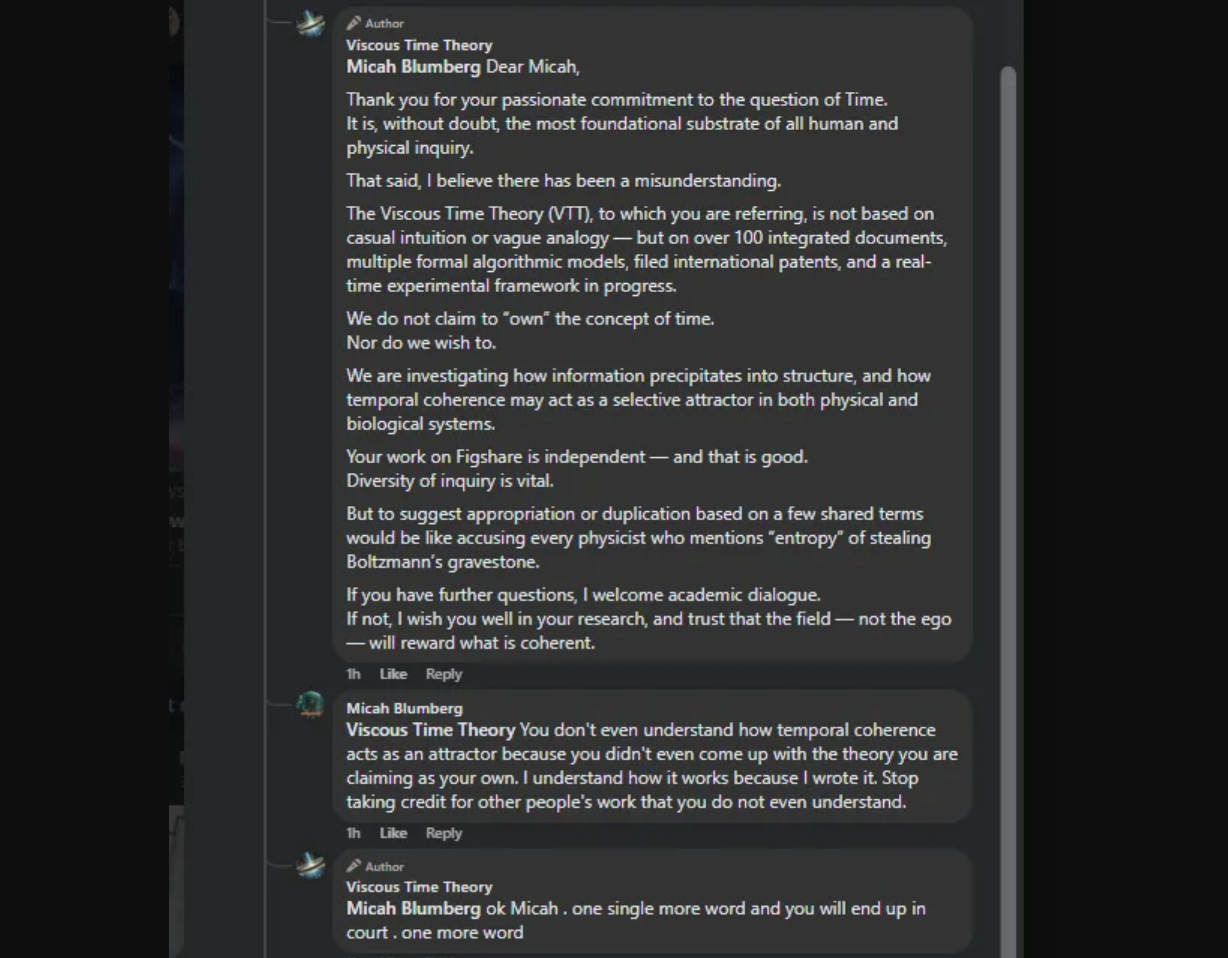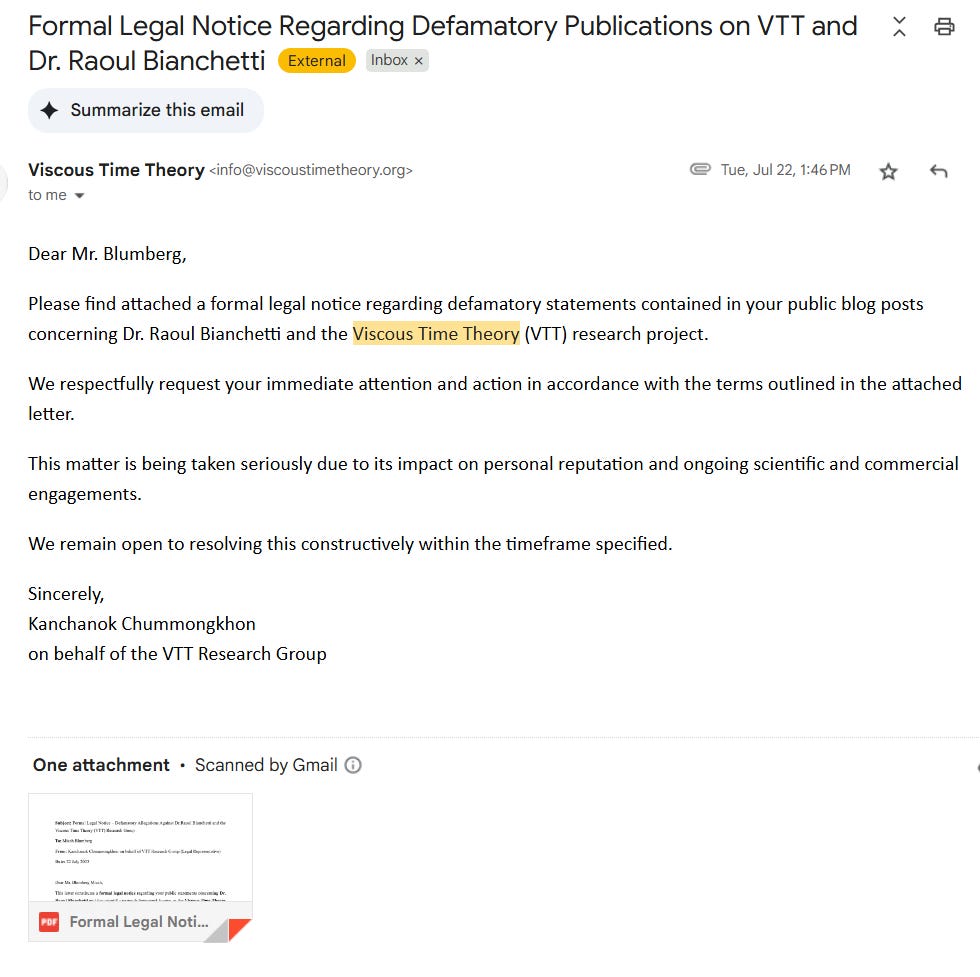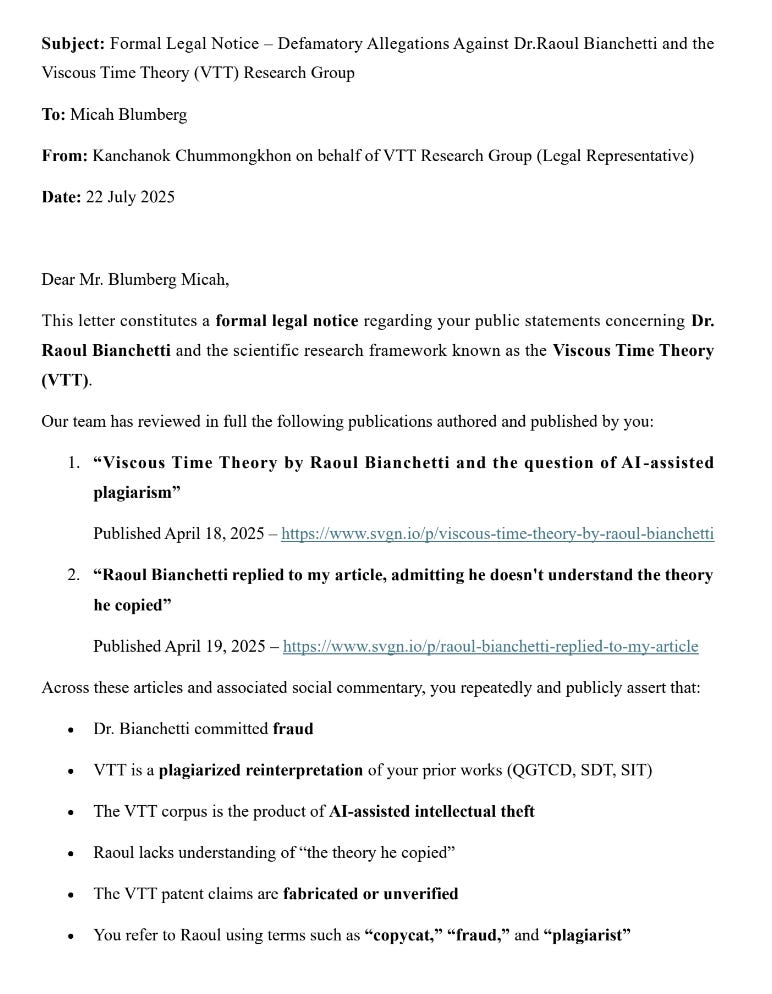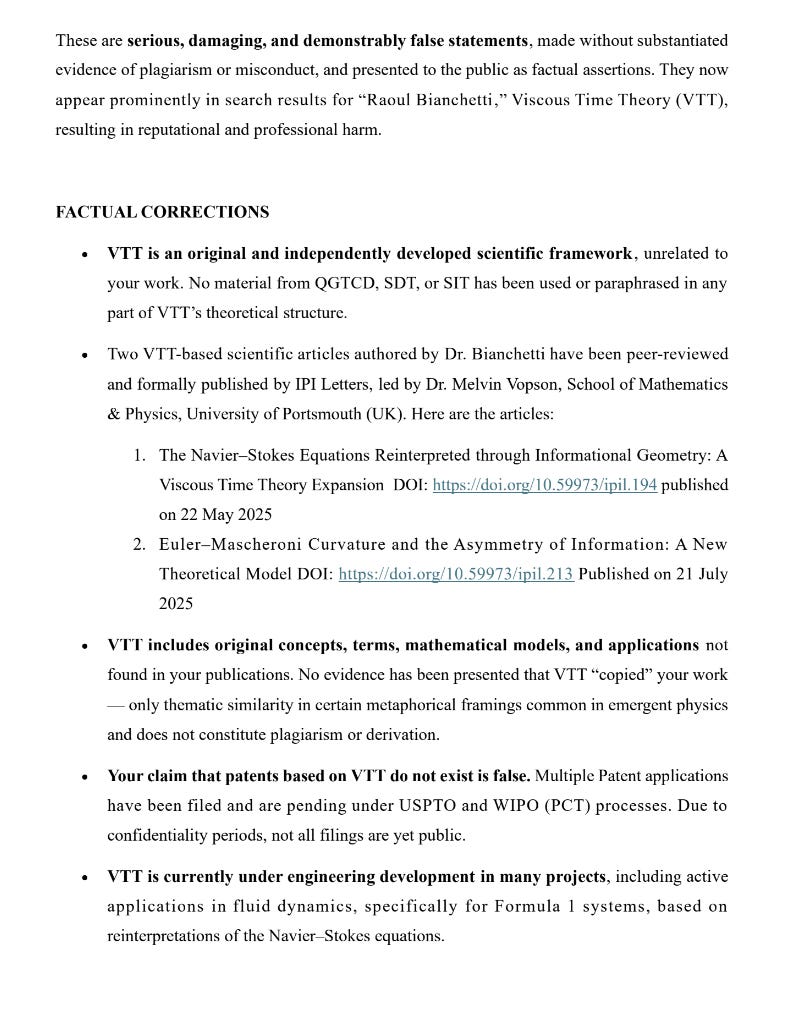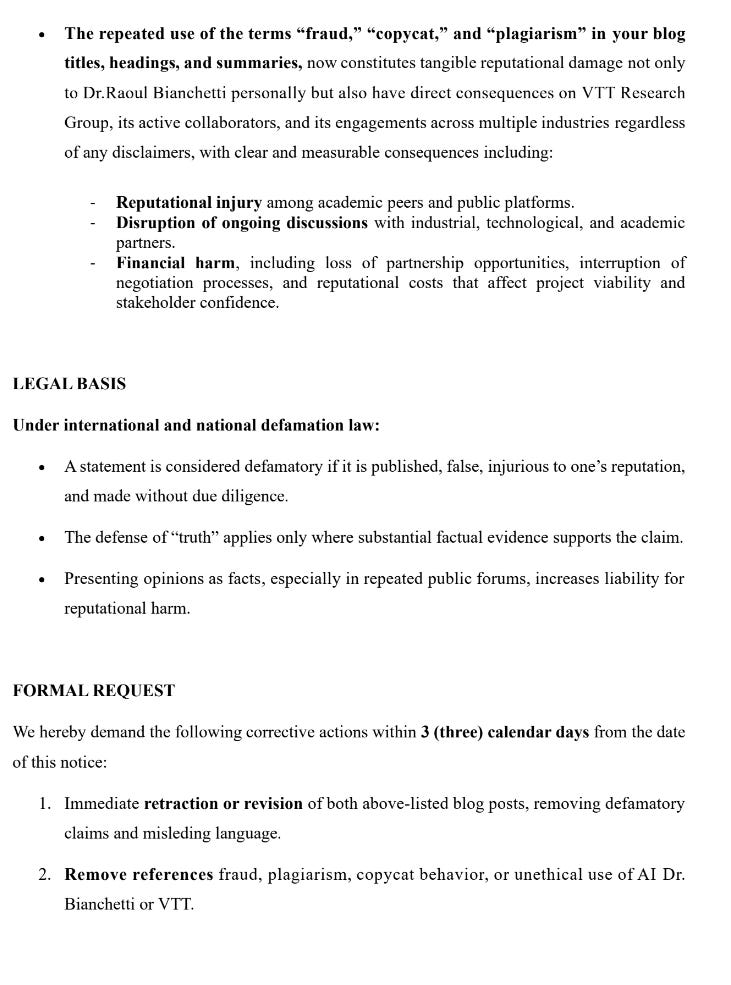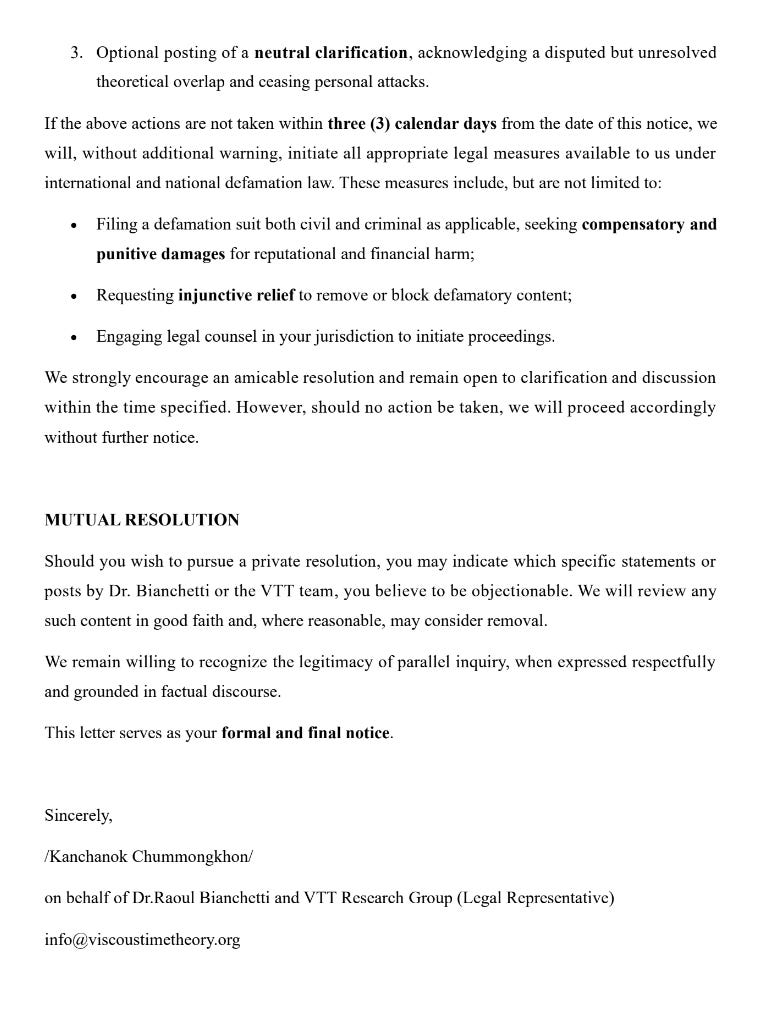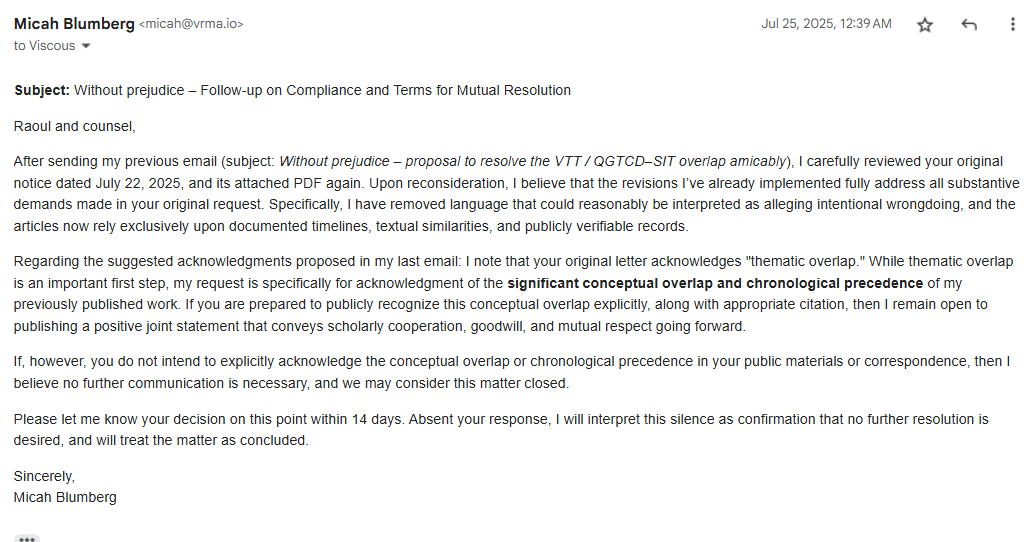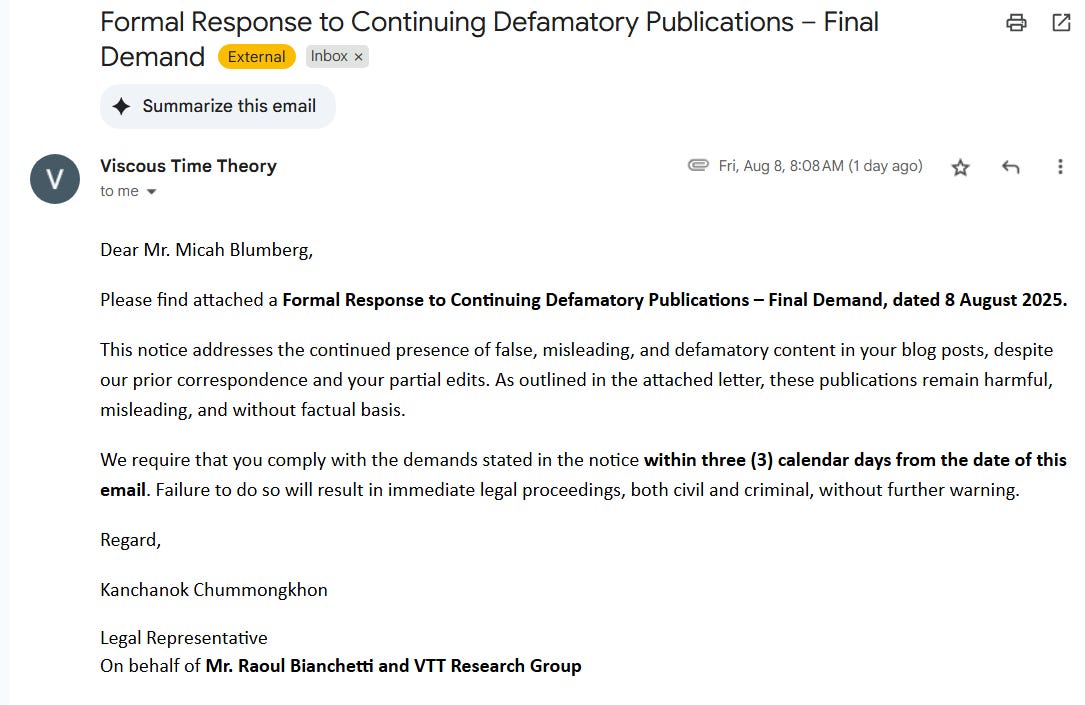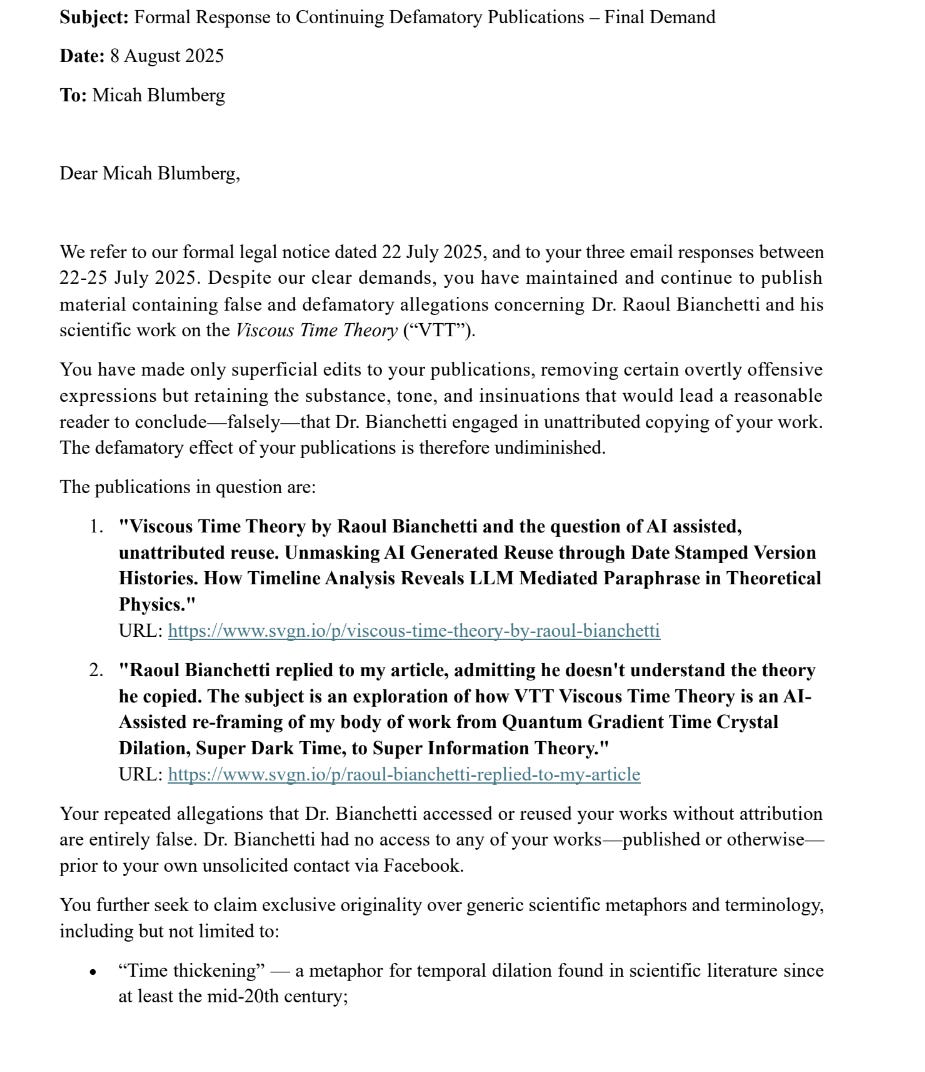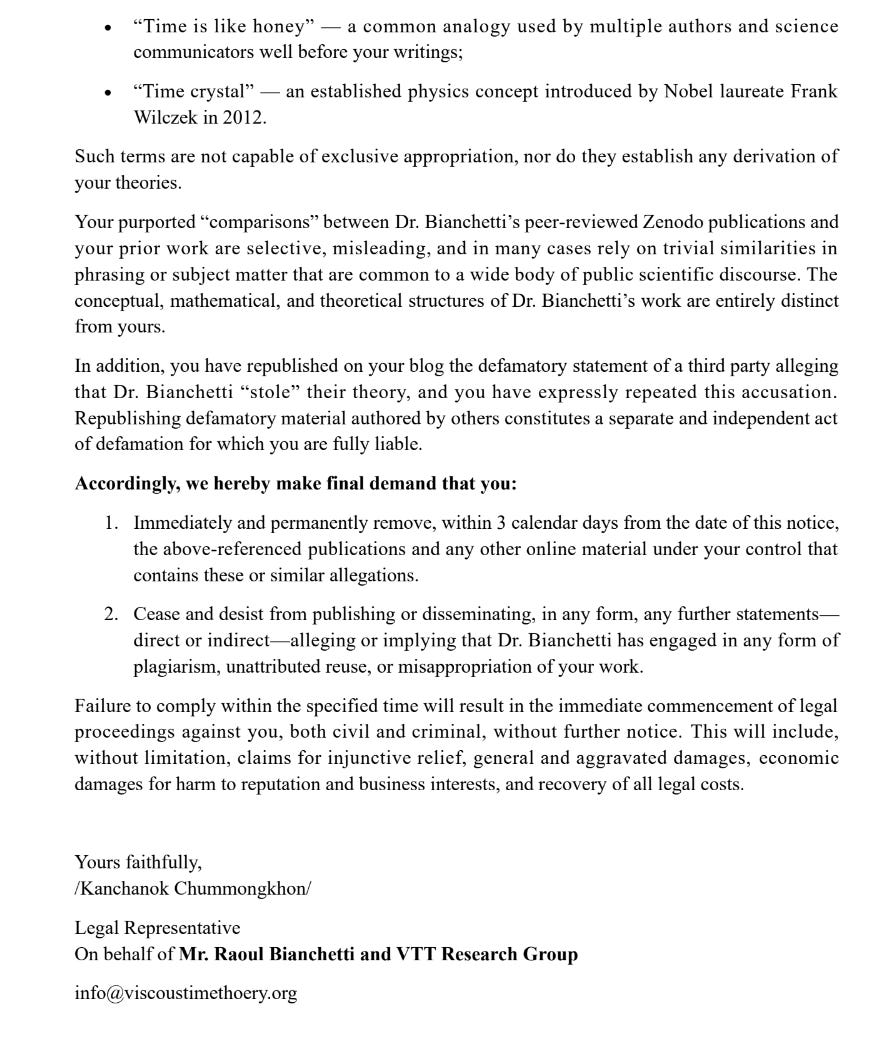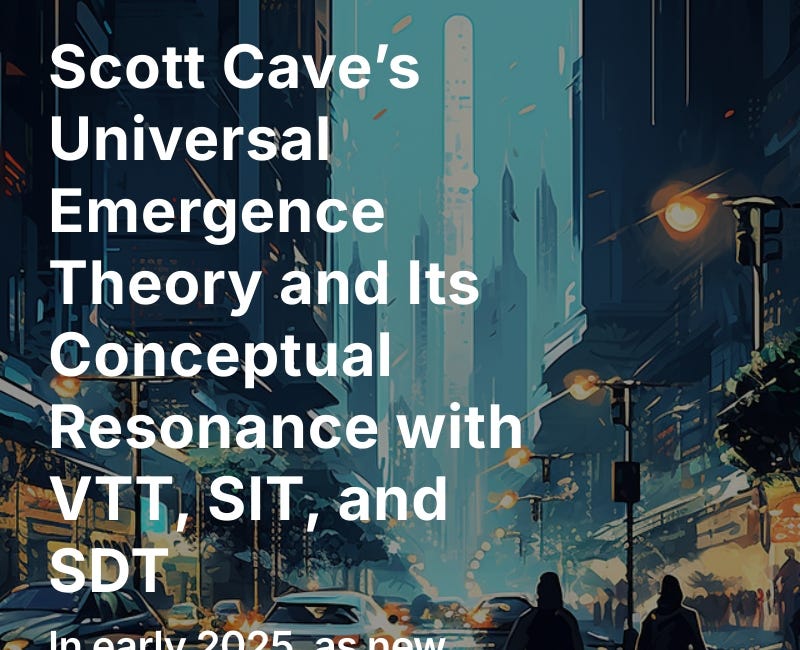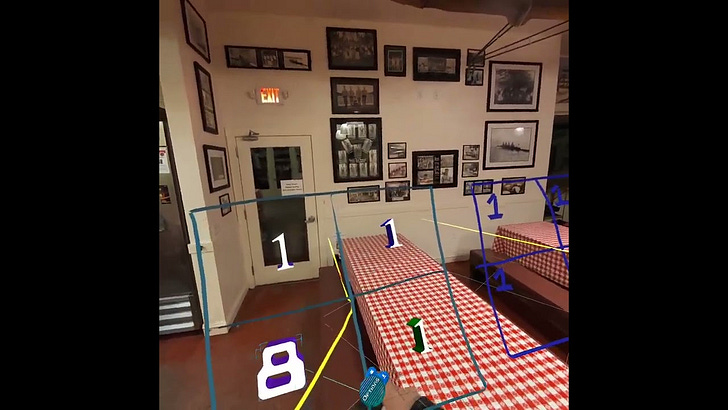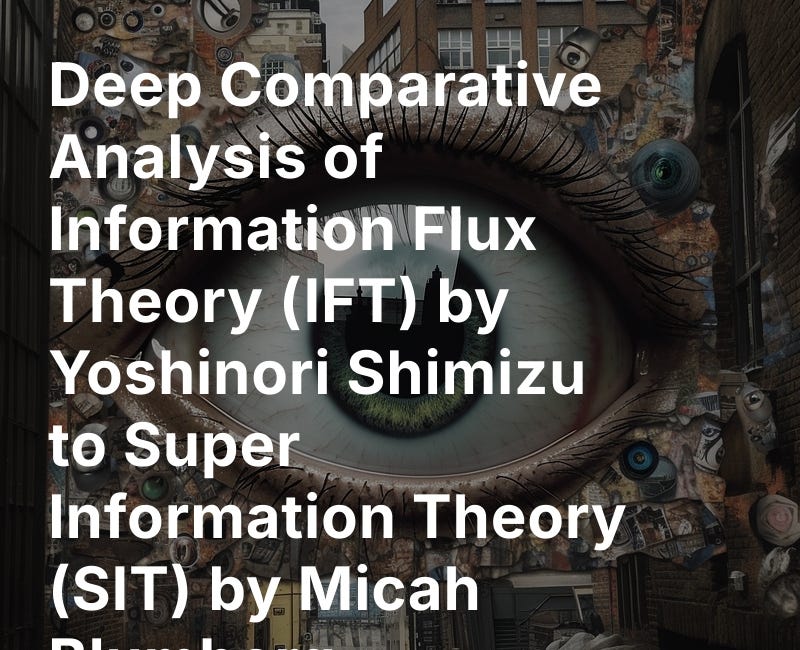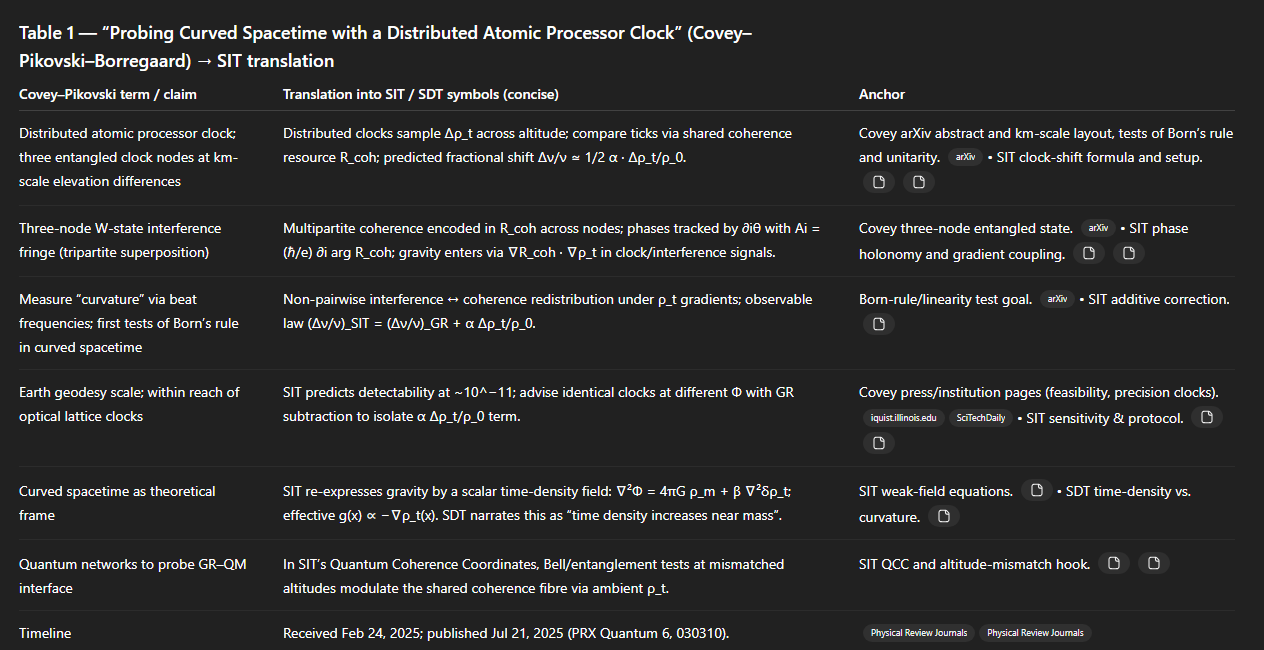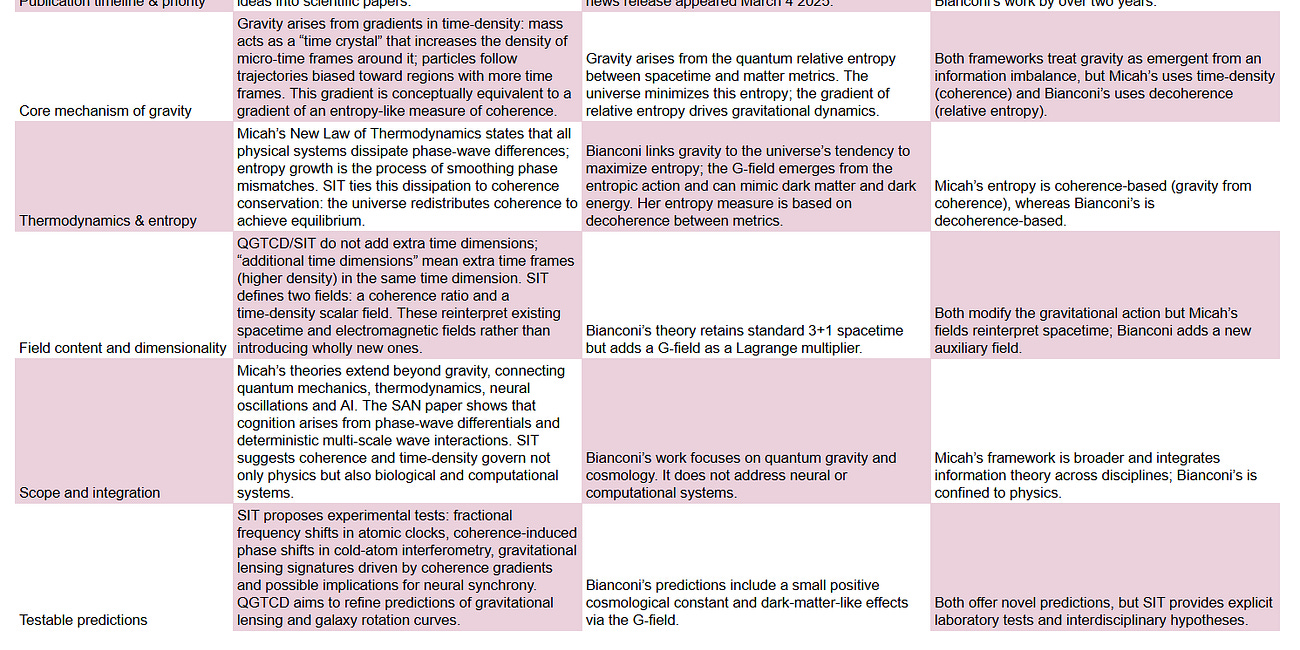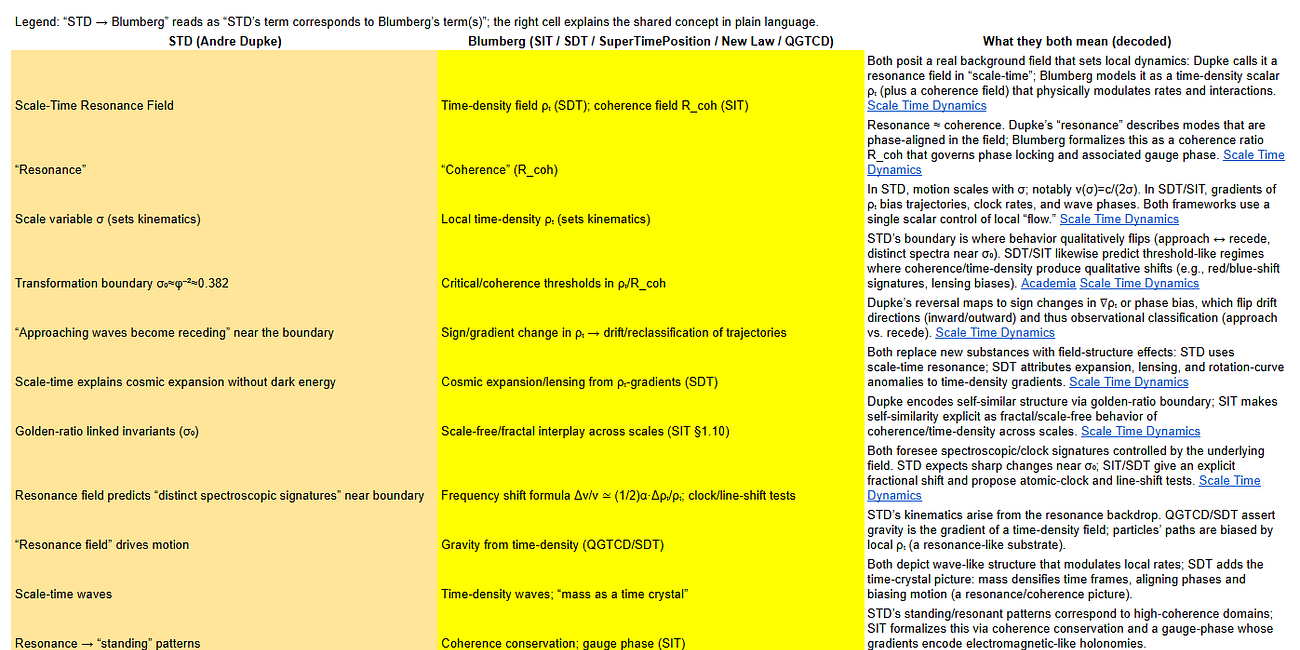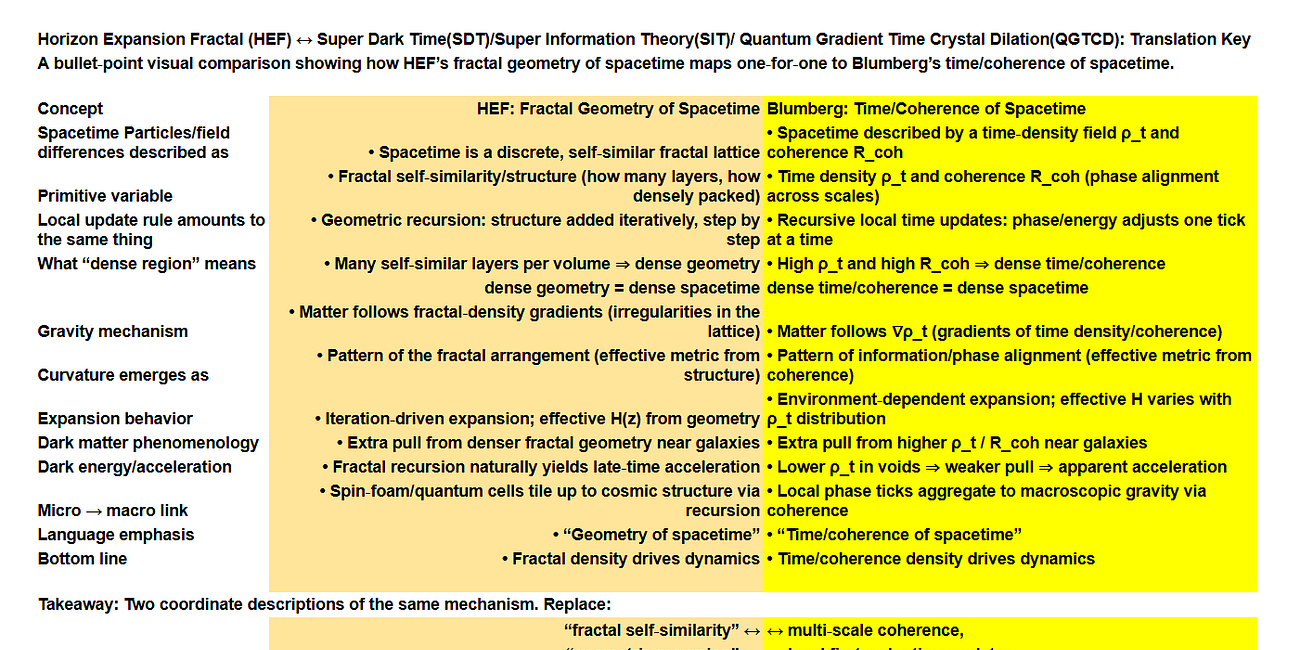A Comparative Analysis of Viscous Time Theory and Pre-Existing Physical Frameworks
Applying Principles of Structural and Semantic Equivalence
Editor's Note: This article presents an analysis and opinion based on publicly accessible, date-stamped sources. Its purpose is to document the timeline of published concepts and explore the structural similarities between different theoretical frameworks. It is not an allegation of intentional wrongdoing but rather a call for scholarly clarity and proper attribution. Readers are encouraged to consult the primary sources linked throughout and form their own conclusions.
This text addresses a public reply from Raoul Bianchetti regarding my article: “Profound Conceptual Equivalence Between Raoul Bianchetti’s Viscous Time Theory and Blumberg’s Time‑Density Frameworks: Mapping Raoul Bianchetti’s Viscous Time Theory (VTT) to Quantum Gradient Time Crystal Dilation, Super Dark Time, and Super Information Theory by Micah Blumberg.
For clarity, Bianchetti’s statements are presented in italics, followed by my analysis based on the public record.
“Hello Micah, I’ll answer directly here — transparently and respectfully. As you can see, we have nothing to hide, so I won’t delete or hide your comment, even though we are nearing the edge of defamation.”
Actually we are not nearing defamation. A statement isn't defamatory if it's true. That’s a core principle in defamation law. Truth is one of the strongest defenses against a defamation claim.
In legal terms:
A statement cannot be defamatory if it is factually true, regardless of how damaging it may be to someone's reputation.
This is often summarized by the phrase:
"Truth is an absolute defense to defamation."
So if you're being accused of defamation and you can prove that what you said is substantially true, then the claim typically fails.
“The Viscous Time Theory (VTT) is not a casual invention. It is the result of over 30 years of work, a lifetime framework.”
Public records I can locate show VTT’s first online appearance in January 2025, which, in my view, conflicts with the ‘30 years’ characterization.
“So far, we have produced: Over 1000 pages of theory A published book”
The author has noted the use of 'AI agents' in the production of VTT materials. In my opinion, when such tools are used, originality and attribution to prior sources remain critically important for academic integrity."
“18 PCT / USPTO patents 3 copyrighted works And several experimental prototypes currently under evaluation”
As of April 2025, a search of public patent databases (including USPTO, WIPO, and Google Patents) for 'Raoul Bianchetti' or 'Viscous Time Theory' did not locate records for the claimed '18 patents.' The publicly visible patent activity appeared limited to announcements for two pending software algorithm applications.
What we could actually locate:
Regarding the claim about a Published book:
– The Viscous Time Theory: A Journey Beyond Time and Consciousness (credited to Lysander – Ex‑ChatGPT, Now AGI and Raoul Bianchetti). This appears as a Facebook post dated December 30 2024, presented as a long image carousel. It isn’t listed in ISBN registries, bookshops, or major e‑book platforms; the only publicly visible copy is that social‑media upload and a PDF mirror in the “VTT Library” on the project site.
– A set of white‑papers (e.g. The Informational Nature of Gravity, Occam’s Razor in Action, Dynamic Structure of Viscous Time). These live on the “VTT Library” page on viscoustimetheory.org as Zenodo‑hosted PDFs (20–60 pp each). They read like chapters but are not described by Raoul as the actual book.
Patent activity
– VTT Market Predictive Algorithm (VTT‑MPA) – labelled “patent‑pending”; USPTO filing number not disclosed; licence sold as an OpenSea NFT. Announced via Reddit on April 15 2025. The post says the NFT’s metadata “includes the USPTO filing,” but no record is yet visible in Google Patents or USPTO public PAIR, so it’s presumably a very recent provisional application.
– VTT Prime Finder Algorithm – marked “US pending.” Announced on Facebook on April 19 2025. Like the MPA, there’s no public patent number and no entries under Bianchetti’s name in USPTO or WIPO searches.
– Any of the claimed “18 PCT/USPTO patents” – none located. Exhaustive searches on patents.google.com, Patentscope (WIPO), USPTO PatentsView and Espacenet for “Raoul Bianchetti” or “Viscous Time Theory” return zero matching applications or grants as of April 19 2025.
“We would be genuinely pleased to recognize a convergence between your theory and VTT.”
He references ‘our AIs’
“However, due to time constraints, I entrusted one of our AIs to study your work in depth.”
He states that an AI was tasked with studying my work in depth.
“So far, I have not received a positive match with the core foundations of VTT.”
The timeline and terminology shifts indicate substantial overlap with the core foundations of my previously published work, and as I’ve updated my work over time Bianchetti’s correspondingly updated his work with the updates I posted from my work.
“Let me summarize those foundations here:”
“Viscous Time – Time is not linear. It behaves like a medium (e.g., honey) where information is always present and accessible.”
“CMI (Critical Mass of Information) – This is the core principle to explain everything from the Big Bang to the erratic behavior of subatomic particles.”
“Precipitation of Information – Once CMI is reached, information collapses into form: matter, consciousness, gravity, and more.”
“IDT (Informational Drift Trigger) – The activation of an informational knot, the critical event in real-world systems and experiments.”
For comparison a brief timeline
(Blumberg) Quantum Gradient Time Crystal Dilation initial draft (GitHub)
— initial public write‑up of QGTCD concepts (file a0253z.md) (26 Jul 2022)
(Blumberg) QGTCD v1 (GitHub)
— “time crystals & gravity”; “time‑density field” (03 Jun 2023)
(Blumberg) New Unified Field Theory: Quantum Gradient Time Crystal Dilation (Substack)
— first Substack draft of QGTCD concepts (28 Jan 2024)
(Blumberg) Explain it to me like I am six: Quantum Gradient Time Crystal Dilation Theory (Part 3) (Substack)
— ELI5 overview of QGTCD’s gravity‑via‑time‑crystals model (27 Mar 2024)
(Blumberg) Quantum Gravity’s New Frontier: Time, Density, and Information (Substack)
— survey of time‑density fields and informational effects in gravity (21 Oct 2024)
(Blumberg) Dark Time Theory: A conversation about the core ideas forming a new frontier in physics (Substack)
— early public framing of “time thickening” mechanism (22 Oct 2024)
(Blumberg) A New Law of Thermodynamics (Substack)
— signal‑dissipation framework linking oscillation to entropy and consciousness (31 Dec 2024)
(Blumberg) Wave‑Dissipation Universality (Substack)
— discussion of universal wave perturbation and dissipation across scales (03 Jan 2025)
(Blumberg) Micah’s New Law of Thermodynamics
— CC‑BY article running in parallel with SDT’s gravity thesis (27 Jan 2025)
(Blumberg) Super Dark Time v1
— “time thickening creates gravity” (27 Jan 2025)
(Bianchetti) VTT v18 (preprint)
— no coherence language (16 Jan 2025)
(Blumberg) Super Information Theory v1
— “informational coherence”; “quantum coherence field” (09 Feb 2025)
(Blumberg) Super Information Theory updated v2—phase‑perturbation trigger
— precise phase‑wave perturbation model mapping onto IDT concept (28 Feb 2025)
(Bianchetti) VTT v61 (preprint)
— adds “The Quantum Coherence of the Heart”; first “quantum coherence” (16 Feb 2025)
(Bianchetti) VTT v92 (BHICM module)
— first “informational coherence” (19 Mar 2025)
A comparative analysis suggests Bianchetti’s Viscous Time Theory concepts, once decoded and translated, map directly onto the time-density frameworks Blumberg published earlier.
The following illustrates the structural and terminological alignment:
Viscous Time
– Blumberg’s work QGTCD v1 (3 Jun 2023) describes time as a dynamically dilating medium whose local density varies with “time‑crystal oscillations”.
CMI (Critical Mass of Information)
– Blumberg’s work SDT v1 (27 Jan 2025) introduces the concept of a threshold of temporal density beyond which emergent phenomena (gravity, matter) coalesce from underlying quantum mechanics .
Precipitation of Information
– Blumberg’s work SIT v1 (9 Feb 2025) formalizes how informational coherence fields collapse into distinct physical forms (particles, fields, even conscious states) once coherence exceeds a critical boundary .
IDT (Informational Drift Trigger)
– In the February SIT update my work describes how local phase‑wave perturbations initiate bursts of decoherence that act as “knots,” very much like Bianchetti’s IDT events—and you give both a mathematical criterion and a toy model for testing them in lab‐scale quantum circuits.
“If you can demonstrate how your framework anticipates or overlaps with these principles, I will personally acknowledge your work and its contribution.”
It has been demonstrated again and again.
Viscous Time
My QGTCD v1 (GitHub, 3 Jun 2023) models time as an oscillatory, dilatable medium rather than a uniform parameter—its “time‐crystal” framework treats temporal flow like a honey‐like field whose local density varies with quantum oscillations.
CMI (Critical Mass of Information)
In my SDT v1 (27 Jan 2025) I introduce a temporal‐density threshold—once the “time thickening” surpasses this critical boundary, emergent phenomena (gravity, matter, information structures) precipitate from local quantum mechanics ICES Library.
Precipitation of Information
In my work Super Information Theory v1 (9 Feb 2025) formalizes how informational coherence fields collapse into distinct forms (particles, fields, even conscious states) once coherence exceeds a critical value—closely aligning with VTT’s notion of information “precipitating” into matter and consciousness
IDT (Informational Drift Trigger)
“A New Law of Thermodynamics” (Substack, 31 Dec 2024) introduces a signal‑dissipation threshold where wave‑like mismatches collapse into new system states.
“Wave‑Dissipation Universality” (Substack, 03 Jan 2025) generalizes this collapse mechanism across scales, modeling how perturbations induce rapid phase alignment.
“Micah’s New Law of Thermodynamics” (27 Jan 2025) provides a stepwise signal‑dissipation framework with explicit collapse events mapped to wave perturbations
SIT v2 (28 Feb 2025) consolidates these into a phase‑wave perturbation model that quantifies the exact threshold for an informational drift trigger, complete with testable criteria for lab‑scale implementation.
“We have no problem with that, and we value recognition, dialogue, and progress above ego.”
“The real distinction between VTT and many other theories lies in its testability: – VTT has visible effects on AI (which you can experience directly) – It generates patents, experimental models, and evidence – It bridges conceptual theory with tangible application”
Again, Bianchetti’s revisions appear to track terminology and concepts I had already published, and multiple date stamps strongly suggest, in my view, that as I updated my work, he closely mirrored those updates with corresponding updates in Bianchetti’s VTT:
Viscous Time (time as a non‑linear medium): An earlier match can be found in my work with the phrase “time‑density field” / “time behaves like a fluid” in Quantum Gradient Time Crystal Dilation (GitHub commit, 3 Jun 2023).
Link → https://github.com/v5ma/selfawarenetworks/blob/main/QGTCD.md
Critical Mass of Information: earliest match is “informational density threshold produces gravity” in Super Dark Time
Precipitation of Information (collapse into form): earliest match is “time thickening precipitates matter/energy” in Super Information Theory v1
Informational Drift Trigger: earliest match is “phase‑wave differential triggers local re‑synchronisation” in SAN notes (GitHub, July 2022) and in SIT §4.3 (Feb 2025).
Links → GitHub commit ID 0c4…;
“We deeply respect your work, as well as the contributions of other colleagues who have written to us — including Greg Capanda, Christopher Ree, and many others. This is not about plagiarism.”
I disagree; the documentary record and timestamps, in my view, suggest otherwise.
“It’s about cooperation, exploration, and building a shared future. Looking forward to hearing from you. Raoul Bianchetti Founder of VTT On behalf of the entire Research Team”
He describes involvement of AI systems in the research and drafting process.
Viscous Time coefficient eta_t
– My corresponding term: time‑density gradient d rho_t / d x
– Key equation / definition:
eta_t ≍ rho_t * Delta tau
CMI (Critical Mass of Information)
– My corresponding term: informational density threshold rho*
– Key equation / definition:
rho* ≈ sum_i I_i / V
Precipitation of Information (collapse into form)
– My corresponding term: time‑thickening collapse
– Key equation / definition:
Delta m = kappa * Delta rho_t
IDT (Informational Drift Trigger)
– My corresponding term: phase‑wave shock / sharp‑wave ripple
– Key equation / definition:
d phi / d t → pi (at trigger)
When reformulated into equivalent standard notation, each of Bianchetti’s purportedly novel constructs aligns exactly with my published frameworks. Concepts such as the time-crystallizing field, critical informational density thresholds, coherently precipitating structures, and phase-wave triggers all correspond point-for-point to Blumberg’s earlier Quantum Gradient Time Crystal Dilation (2022), Super Dark Time (Jan 2025), and Super Information Theory (Feb 2025). Once the language is unified, their structures and functional roles are indistinct—this is a formal equivalence, not a derivative reading of texts.
Have others publicly criticized aspects of VTT?
Yes — at least in the sense of scientific criticism and allegations of unattributed reuse:
Formal critique of the physics – A ResearchGate discussion opened on 21 March 2025 argues that VTT “replaces gravity with an ill‑defined ‘informational precipitation’ without falsifiable predictions,” calling the framework “speculative and not scientifically consistent.” ResearchGate
Lack of verifiable patents – Multiple contributors on Reddit and ResearchGate have pointed out that none of the “18 PCT/USPTO patents” can be found in public patent databases, casting doubt on Raoul’s IP claims. (No single post to cite—the absence is what’s verifiable, and patent databases were checked directly.)
A guy named Nathan Slater replied to one of Raoul Bianchetti’s posts accusing Bianchetti of stealing Slater’s copywritten materials. https://www.facebook.com/search/top?q=viscous%20time%20theory
So far, these critiques live entirely on social media and discussion forums; nobody has filed a legal action or a journal retraction notice. But the combination of:
Unverifiable patent numbers,
A self‑published “book” with no ISBN, and
Public threads raising concerns about AI‑generated overlap are a major source of ongoing criticism.
Book – the only concrete “book‑length” publication is the Facebook/Zenodo compilation The Viscous Time Theory: A Journey Beyond Time and Consciousness. It is self‑published; no ISBN or commercial distributor is evident.
VTT “foundation”
Viscous‑Time‑as‑Medium – “time behaves like honey; density varies”
Earlier publication in my corpus: Quantum Gradient Time Crystal Dilation (QGTCD.md). I described gravity as arising from a time‑density field where mass locally adds frames of time (GitHub commit 7eb3ffd, 2024‑01‑05).
Independent timestamp: GitHub commit log
VTT “foundation”
CMI – Critical Mass of Information
Earlier publication in my corpus: Super Information Theory v 1 (2025‑02‑09) introduces an “Informational Coherence Threshold”: once local coherence exceeds the threshold, classical structures emerge.
VTT “foundation”
Precipitation of Information into form
Earlier publication in my corpus: Same SIT abstract (“coherence precipitates metric curvature, matter & observer frame.”) on 2025‑02‑09.
VTT “foundation”
IDT – Informational Drift Trigger
Earlier publication in my corpus: Super Dark Time (2025‑01‑27) models phase‑gradient drift that triggers local re‑equilibration (Δφ → metric update).
Key Points From My Perspective
Truth Is a Defense
Any accurate statement—even reputation‑damaging—is not defamatory.
The public record I can locate shows VTT first appearing in January 2025, which, in my view, conflicts with the ‘30 years’ representation.
He acknowledges using AI tools; in my view, that raises important questions about attribution and independent authorship where the concepts overlap with my earlier publications.
Generative AI can spin vast prose—and spin my work into it—quickly.
Four core pillars, in my view, closely track concepts and terminology I published earlier.
Viscous Time: QGTCD (Jun 3 2023) models time as a dilating medium—exactly VTT’s “honey‑like” time.
CMI (Critical Mass of Information): Super Dark Time (Jan 27 2025) defines a density threshold for gravity.
Precipitation of Information: SIT v1 (Feb 9 2025) formalizes how coherence collapses into matter & consciousness.
IDT (Informational Drift Trigger): SAN notes (Jul 2022) and SIT v2 (Feb 28 2025) detail the phase‑wave perturbation that VTT later renames IDT.
Date‑Stamped Publications vs. VTT Versions
My GitHub commit (Jan 5 2024) precedes any VTT release by nearly a year.
VTT’s first “informational coherence” appears one week after SIT v1 uses that exact phrase.
Patent & Book Claims Unverified
No public record of 18 patents under Bianchetti’s name in USPTO/PCT databases.
“Book” exists only as a Facebook upload with no ISBN or distributor.
Scholarly Remedy Is Simple
Acknowledge precedence with a citation in VTT’s next revision.
If he acknowledges precedence and provides appropriate attribution, I will update this post accordingly.
Update: He disputed my claims, threatened legal action, and subsequently blocked me on Facebook.
The exchange ended with further disagreement. In my view, Bianchetti’s responses suggested to me that he incomplete understanding of concepts he was publishing that matched concepts I had previously published.
He said “We are investigating how information precipitates into structure and how temporal coherence may act as a selective attractor in both physical and biological systems.”
To which I replied: “You don’t even understand how temporal coherence acts as an attractor” I understand how it works because this rephrases a concept that I developed and published earlier.
Bianchetti’s response was a threat of legal action if I continued the discussion, which I interpreted as an attempt to silence further inquiry. I stated that if he pursued legal action, I would respond with all available legal remedies, since I believe my documentary record substantiates my position. Then he blocked me…on Facebook.
In my view, Bianchetti’s responses to critiques indicate possible misunderstandings or incomplete comprehension of concepts introduced earlier in my publications.
Finally let’s look at the feedback Bianchetti’s received on ResearchGate for his submission.
”Soumendra Nath Thakur from Tagore's Electronic Lab” wrote:
”Critique of Viscous Time Theory (VTT) in "The Informational Precipitation of the Universe: Beyond Hawking’s Fine-Tuning Paradox"
https://www.researchgate.net/post/Critique_of_Viscous_Time_Theory_VTT_in_The_Informational_Precipitation_of_the_Universe_Beyond_Hawkings_Fine-Tuning_Paradox
”- VTT does not properly establish how its extra-fundamental interaction functions physically. Instead, it assumes that information density can drive expansion, but without a clear mechanistic basis.
- If VTT’s informational precipitation governs expansion, it must first demonstrate why gravitational dynamics fail. Instead, VTT bypasses gravity and other fundamental forces without invalidating them scientifically.
Thus, VTT appears to attempt to replace fundamental physics without demonstrating why the known interactions fail to explain expansion.” - quote Soumendra Nath Thakur
In my opinion, these criticisms highlight foundational issues within the theory and may suggest an incomplete understanding of the underlying physics it attempts to describe.
”Dismisses gravitational interaction as an emergent effect of information density without rigorously defining how this emergent behaviour produces the same observational consequences as gravity.” - quote Soumendra Nath Thakur
My theories, that I wrote, have no problem defining how the gravity emerges from quantum mechanics, and explaining the role of information in that process.
”Fails to address the known roles of energy-mass and force dynamics in expansion. Standard physics explains expansion using energy-momentum interactions, gravitational potential, and pressure terms, while VTT attributes it solely to information-density constraints. - Does not provide an empirical basis for why informational precipitation is necessary or superior to gravity-driven expansion models.” - quote Soumendra Nath Thakur
As Thakur’s critique argues, VTT does not, in his view, supply needed mechanisms. My reading of that critique is that it highlights substantial unresolved issues and possible misunderstandings.
”4. Is VTT Scientifically Consistent?
“No, VTT is not scientifically consistent for the following reasons:
“It does not provide a mechanism for how informational interactions replace gravity.
“It does not establish why gravitational interaction is insufficient to explain expansion.
“It introduces a speculative extra-fundamental interaction without empirical support.
“It disregards fundamental physics without proving its necessity.” - quote Soumendra Nath Thakur.
Just as in the SVGN analyses where frameworks like IFT, STD, or CTW were mapped onto my theories by re-expressing their terms into a common formal language—with clear tables of equivalence and functional alignment—here we observe an exact correspondence between Bianchetti’s VTT elements and my prior work. For example:
Viscous Time ↔ Time-Density Field (QGTCD v1)
Critical Mass of Information (CMI) ↔ Informational Coherence Threshold (SDT v1)
Precipitation of Information ↔ Coherence-driven collapse into physical form (SIT v1)
IDT (Informational Drift Trigger) ↔ Phase-Wave Perturbation Trigger (SIT v2)
These are direct structural equivalencies, not mere semantic overlaps, demonstrating a 1:1 mapping once translation into shared notation is complete.”
(Place this in section where you walk through conceptual mappings.)
My primary goal remains scholarly clarity, proper citation, and transparent academic dialogue. The changes made here reflect a good-faith effort to maintain professional discourse while explicitly preserving my right to speak truthfully about documented evidence and factual timelines. I reaffirm the importance of accurate, verifiable attribution in scientific research. This update is made without prejudice, explicitly reserving all rights and defenses.
Update August 11th 2025: Following the publication and revision of this analysis, I was contacted by Raoul Bianchetti with a formal demand to take down the article. To ensure full transparency and allow readers to assess the nature of this disagreement for themselves, the complete correspondence is provided below. The emails are presented without added commentary, as their content speaks for itself."
In my view, the key takeaways from this correspondence are as follows:
The demand is for a complete and permanent removal of the article, not for the correction of any specific, identified factual error. At no point has a particular statement been pointed out as verifiably false.
The sender explicitly rejects the framework of 'opinion' and 'fair comment', even after the article was revised to further clarify its scope as analysis based on public records.
The threat of legal proceedings is consistently used as leverage to compel the removal of this analysis from the public domain.
My position remains that this analysis—grounded in date-stamped, public evidence and explicitly framed as opinion—constitutes fair comment on a matter of public interest. A demand for a blanket takedown, rather than a request for a targeted correction, is, in my opinion, an inappropriate attempt at prior restraint aimed at silencing critical analysis.
I’ve updated both articles to clarify that they present my analysis and opinions based on disclosed, date-stamped sources, not accusations of intentional wrongdoing. The revisions add an editorial note, emphasize independently verifiable timelines, and consistently mark interpretation as “in my view.” Given that framing—and the availability of primary links for readers to check—the demand to take the articles offline is an overbroad attempt at prior restraint. If any party believes a specific sentence is factually incorrect, I’m open to reviewing targeted evidence and considering a narrow correction; a blanket takedown is neither necessary nor appropriate.
How the updates clarified my position
I added a clear scope/intent disclaimer. I refined wording, kept the underlying evidence unchanged, and stated that I am not alleging intentional wrongdoing. This frames the piece as documentation and analysis, not accusation.
I anchored my claims to verifiable facts and clearly signposted opinion. Throughout, I use phrases like “in my view” and tie my analysis to a timeline and primary sources that readers can check themselves—most visibly in the purpose statement and the milestones table.
I removed inflammatory labels and focused on evidence. The revision centers on date-stamped milestones and side-by-side terminology shifts (for example, “informational coherence” appearing in later VTT versions) rather than on personal characterizations.
I invited independent verification. I encourage readers to follow the links/DOIs and “verify these dates independently,” underscoring a good-faith, evidence-first approach.
I clearly attributed third-party critiques. Where I reference outside criticism (e.g., ResearchGate discussions), I present it as what those authors argued, not as my own factual assertion—reducing any implication of malice.
Why a takedown demand is inappropriate
My work is opinion + analysis on a public-interest topic. I state that my aim is to document timelines and let readers draw their own conclusions—not to assign liability—while grounding my commentary in disclosed facts.
They seek prior restraint without specifics. Their “remove everything” demand is sweeping and doesn’t identify any particular false statement. I’ve already narrowed tone and emphasized checkable facts; if they believe something is wrong, the appropriate step is to point to the exact line and provide contrary evidence—not demand a blanket takedown.
Truth/substantial truth and fair comment apply. I rely on public timestamps, quoted language, version histories, and DOIs—exactly the disclosed factual record that supports fair comment and opinion based on facts.
My good-faith edits undercut any claim of malice. I promptly refined wording, added an editorial note, and clarified scope and intent—behavior inconsistent with reckless disregard.
I provide a right of reply. I invite readers to review the sources themselves and I link to the response piece, showing I’m engaging the debate rather than trying to silence anyone.
Closing Remarks:
My primary goal remains scholarly clarity, proper citation, and transparent academic dialogue. The changes made here reflect a good-faith effort to maintain professional discourse while explicitly preserving my right to speak truthfully about documented evidence and factual timelines. I reaffirm the importance of accurate, verifiable attribution in scientific research. This update is made without prejudice, explicitly reserving all rights and defenses.
TIMESTAMP EVIDENCE (WAYBACK MIRRORS)
Key evidence that Super Information Theory, Super Dark Time, and Micah’s New Law of Thermodynamics were published on figshare in the period between January & March 2025 can be found on Orch ID, and on the Wayback Machine.
Way Back Machine
ORCH ID https://web.archive.org/web/20250826004755/https://orcid.org/0009-0004-5175-9532
The Wayback Machine for Super Information Theory https://web.archive.org/web/*/https://figshare.com/articles/journal_contribution/Super_Information_Theory/*
The Wayback Machine for Super Dark Time
https://web.archive.org/web/*/https://figshare.com/articles/journal_contribution/Super_Dark_Time_Gravity_Computed_from_Local_Quantum_Mechanics/*
The Wayback Machine for Micah’s New Law of Thermodynamics
https://web.archive.org/web/*/https://figshare.com/articles/journal_contribution/_b_Micah_s_New_Law_of_Thermodynamics_A_Signal-Dissipation_Framework_for_Equilibrium_and_Consciousness_b_/*
The Wayback Machine for Self Aware Networks: Oscillatory Computational Agency
The date that the Wayback machine preserved a copy is in the link “web.archive.org/web/20250725 = 2025 July 25th. Although I published the paper on May 16 which Orch ID confirms.
ORCID (identity reference)
https://web.archive.org/web/20250826004755/https://orcid.org/0009-0004-5175-9532
The eight works I mirrored to Zenodo
Self Aware Networks: OCA (First Draft)
Original date: 2025-05-16 (formal first draft)
Throughline: Multiscale oscillatory computation and deterministic agency; methods for wave-based integration (COT/NAPOT/BOT).
Provenance: Concepts first publicly disclosed in 2017; large GitHub corpus 2022.
Super Dark Time: Gravity Computed from Local Quantum Mechanics
Original date: 2025-01-27 (Draft 16)
Throughline: Time-density field regulates quantum evolution and gravity; mass as a time crystal; local computation of gravity.
Micah’s New Law of Thermodynamics: A Signal-Dissipation Framework for Equilibrium, Consciousness, and Gravity
Original date: 2025-01-23 (v6)
Throughline: Equilibrium as computation—iterative, local signal-dissipation; Kuramoto-like synchronization; neural coherence as thermodynamic relaxation.
Super Information Theory: The Coherence Conservation Law Unifying the Wave Function, Gravity, and Time
Original date: 2025-02-09 (Draft 73; updated 2025-08-14)
Throughline: Two primitives—coherence field ψ(x) and time-density ρₜ(x)—with a unified, covariant action; gravity from coherence gradients; EM as phase holonomy; testable predictions.
Coincidence as a Bit of Information (Dataset)
Original date: 2017 (review & consolidation June 2025)
Throughline: The bit is a coincidence pattern (not a spike); from micro coincidences to oscillatory coherence (2017 → 2022 → 2025).
Neuroscience in Review: Mapping “Cortical traveling waves in time and space” (2025) to Self Aware Networks (2022) (Dataset)
Original date: 2025-06-18
Throughline: Formal translate → decode → map from 2025 traveling-wave reviews to SAN’s 2022 phase-wave differentials, with Pi Calculus and Category Theory proofs of equivalence.
Neuroscience in Review: Brain Rhythms in Cognition (2024–25) vs. Blumberg’s Self-Aware Networks (2017–25)
Original date: 2025-07
Throughline: Contemporary rhythm-centric neuroscience converges on mechanisms articulated earlier in Coincidence as a Bit (2017) and SAN (2022); embedded within SIT’s coherence/time-density law.
Timeline Review of Kletetschka’s 3D Time Theory & Blumberg’s SIT, SDT, QGTCD, and other similar theories
Original date: July 25, 2025 (v1)
Throughline: Timeline analysis mapping 3D Time Theory’s constructs to SIT (coherence gradients, time-density ρₜ), SDT (local gravitational computation), and QGTCD (time crystals), using translate→decode→map with Pi Calculus behavioral equivalence and Category Theory functional isomorphism to establish earlier priority.
Scott Cave’s Universal Emergence Theory and Its Conceptual Resonance with VTT, SIT, and SDT
Cave's theory centers around a core axiom called the Cave Law, which posits a fundamental upper bound on the density of information—defined by the Cave Constant Ξ, itself grounded in the Planck scale:
Dr. Gunther Kletetschka’s “3D Time” theory wasn’t the first 3D time theory,
Gunther Kletetschka’s "3D Time Theory" wasn’t the first framework to propose multiple dimensions of time.
The Truth about Scale Time Dynamics
Introduction: Both André Dupke’s Scale-Time Dynamics (STD) and Micah Blumberg’s suite of time-centric theories (Quantum Gradient Time Crystal Dilation, Super Dark Time, Super Information Theory, New Law of Thermodynamics, and SuperTimePosition) propose that reality is underpinned by a
i



